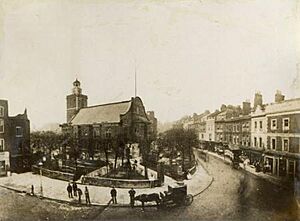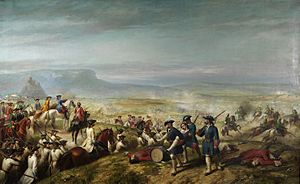Lord Mark Kerr (British Army officer, born 1676) facts for kids
Quick facts for kids
Lord Mark Kerr
|
|
|---|---|
| Born | 1 April 1676 (baptismal date) Newbattle, Midlothian |
| Died | 2 February 1752 Kensington, London |
| Buried | |
| Allegiance | |
| Service/ |
Army |
| Years of service | 1694-1719 (Active service) |
| Rank | General |
| Unit | 29th Foot; 13th Foot; 11th Hussars |
| Commands held | Commander, Counties Down and Antrim, 1716; |
| Battles/wars | War of the Spanish Succession1702-1714 Almansa, 1707; War of the Quadruple Alliance Capture of Vigo, 1719 |
| Other work | Governor of Carrickfergus 1716 Governor of Sheerness 1729 Governor, Berwick-upon-Tweed Governor of Edinburgh Castle 1745-1752 |
Lord Mark Kerr (born 1676 – died 1752) was a Scottish soldier. He became a General in the British Army. He fought in important wars like the War of the Spanish Succession. He also held key jobs, such as Governor of Edinburgh Castle.
Contents
Lord Mark Kerr: A Scottish General
Early Life and Family
Lord Mark Kerr was born in 1676. He was the fourth son of Robert Kerr, the first Marquess of Lothian. His mother was Jean Campbell. His family had strong ties to the Whig political group. They supported the Glorious Revolution in 1688. This event changed who ruled Britain.
Lord Mark Kerr never married. He passed away in London on February 2, 1752. He was buried in St Mary Abbots church in Kensington. The church was rebuilt later, so his memorial is no longer there.
Military Career Highlights
First Steps in the Army
In 1696, Lord Mark Kerr became a Captain in 'McGill's Regiment of Foot.' This unit was later disbanded. He then moved to 'Lord Jedburgh's Dragoons.' This regiment was owned by his older brother.
Fighting in Spain: The Battle of Almansa
When the War of the Spanish Succession started in 1702, he joined a new regiment. It served in a region called Flanders. In 1706, he became a Colonel. His new unit was called 'Lord Mark Kerr's Regiment of Foot.'
His regiment was sent to Spain. They supported Archduke Charles, who wanted to be king. In April 1707, they fought in the Battle of Almansa. The British and Portuguese soldiers were left alone. Their cavalry (soldiers on horseback) had been defeated. Lord Mark Kerr was wounded in the battle. His regiment lost many soldiers.
The remaining soldiers bravely retreated. They marched about 8 miles from the battlefield. They ran out of ammunition, food, and water. The next day, they had to surrender. The enemy commander, the Duke of Berwick, invited the captured officers to dinner.
Because of their heavy losses, his regiment was reformed in 1709. It was then disbanded two years later. This happened because the government reduced the army. Lord Mark Kerr was promoted to Brigadier-General. However, many of his junior officers lost their full pay. Some of them later joined the Jacobite Rising in 1715.
Important Commands and Promotions
In 1712, Lord Mark Kerr became Colonel of the 29th Foot. This regiment was sent to Gibraltar. It stayed there for the next 30 years. Lord Mark Kerr might not have joined them in Gibraltar. In 1716, he was made Governor of Carrickfergus. He also became the military commander for Counties Down and Antrim in Ireland.
During the War of the Quadruple Alliance, Spain supported the Jacobite Rising of 1719. This uprising was quickly stopped. To get back at Spain, Britain sent a naval force. In October, 6,000 British troops landed in the Spanish port of Vigo. They held the port for ten days. They destroyed many supplies and equipment. Then they left without any fighting. Lord Mark Kerr commanded part of this landing force. This was likely his last active military command.
In those days, being a 'Colonel' often meant owning the regiment. It did not always mean leading it in battle. Many colonels had other officers do the actual commanding.
Later Life and Important Roles
Lord Mark Kerr became Colonel of the 13th Regiment of Foot in 1725. He was promoted to Major-General in 1727. In 1729, he became Governor of Sheerness. In 1732, he took command of the 11th Hussars. He was promoted to Lieutenant-General in 1735. Finally, he became a full General on February 26, 1743.
When the Jacobite Rising began in August 1745, he was Governor of Berwick-upon-Tweed. He was appointed Governor of Edinburgh Castle in November 1745. This happened after government forces took back the city. He died in London in 1752.




